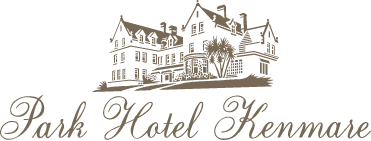John Moriarty’s Kerry Way Walk
Galway’s Bridge to Kenmare a distance of 7 miles (11.5 km) Class Moderate
Beginning at Galway’s Bridge with the beautiful old, now closed church of Derrycunnihy (Opened on 24th Oct 1874, consecrated St. Mary of the Angles 13th Nov. 1874) on the right. We set out on well paved track, the river also called after Galway, on our left. Further to the left we begin to see some of Irelands oldest Oak woodlands. It is the best example of a damp-climate oceanic wood with luxuriant growth of mosses and ferns high up in the trees. This section has been continually forested with Oak since the last ice age, about 11,000 years ago.
Shortly we swing around to the right; the Valley opens up before us. In the distance the ridge of Windy Gap our highest point of the walk at 320M above sea level. The track snakes up the glen in front of us. To our right and left some great examples of raised bog land, in the reed stage of its life. The track branches off to the left for Killarney. It is so interesting to see this very perfect Slí (or way) not changed in the many centuries of our history. Crossing the first of 7 streams the diligent will find the letters. E. D carved in the stepping-stone. On the next larger water crossing E. had time to record his family name, Doyle. He was keen to be remembered as I have found him on 4 places on this stage of the Kerry way. I believe he was part of the Tipperary Regiment who was mapping this region (1829 to 1842) Further near Killarney there are dates also attached to the names of many soldiers as the name James O Neill Tipp. Reg. is clearly read. It is interesting to note that Ordnance Survey Ireland has evolved from the Ordnance Survey Office, which was established in 1824. This Office was initially part of the army under the Department of Defense. All staff employed by the Office were military until the 1970s when the first civilian employees were recruited.
With a keen eye we will pick out the sad remains of potato fields abandoned in the famine. A mile in we have a great view over our covered ground and on towards Torc mountain peaking up in the distance. In the far distance we see the famine fields of the 1840 to the 1860, in one of the Glens 262 people were recorded living there in the census of 1840s by 1862 not a soul remained. Their humble homes being demolished by the crowbar gangs of the landlords. However well kept fields of their time remain as strong and loyal witness to the memory of the people of this Glen and those very sad years of Irish history.
Climbing up we come to a pretty well preserved famine ruin and field complete with Paircíne. The Paircíne was hidden in the long grass for many years only being revealed after a mountain fire burned back the growth. The little en closure on the back left was where one would keep the most important few animals at night time for safety, at the time, goats, ancestors of the wild goats of today. More importantly it is a great economic statement of the time, being so small it clearly shows how little people had. Some paces further is a very well defined example of a potato field, in its time there were 14 ridges here. As they are sound to this day we know that the last crop was never dug out. Either the potato had failed or the people abandoned the meager living.
Climbing upwards we soon reach the highest point of our climb 320 M above sea level at Windy Gap with Peakeen 555M and Knockanaguish 509 M mountains right and left, as well as superb views of the surrounding hills. Kenmare Bay can be seen to the SE, Beara Peninsula in the distance. We begin our decent towards Kenmare. Passing Gowlan and its standing stones, the fever hospital and site of the Work House and Soup Kitchen. Holy Cross Church was built in 1864, is a beautiful sight as we enter Kenmare town and return to the Hotel, in time to check out the Spa and lunch.





